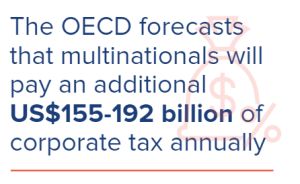Few developments in the tax world have an impact on a truly global scale, but the so-called 'Pillar Two' rules – essentially a global minimum corporate tax – is one of them.
Pillar Two arose from the Organisation for Economic Co-operation and Development's (OECD) Base Erosion and Profit Shifting (BEPS) project. Agreed in principle in 2021 by around 140 countries, Pillar Two is designed to end the 'race to the bottom' for corporate tax rates and remove the advantages of shifting profits to low-tax jurisdictions.
The rules operate by ensuring that large multinationals (those with consolidated annual revenue exceeding €750 million) pay a minimum 15% effective corporate tax rate in every jurisdiction in which they operate. This is achieved through a series of inter-locking international rules (to be implemented through domestic legislation in adopting countries) which essentially levy a 'top-up tax' on income which is taxed below this level. If the profits of a multinational are taxed at below 15% in one country, other countries are able to charge a top-up tax. The tax is most often payable by the ultimate parent company of a group but may also be levied at a lower level in the group structure. The rules include an optional domestic top-up tax, which means that wholly domestic groups may also be affected by the new regime. Ultimately, in the longer term, it is likely that most, if not all, jurisdictions will implement domestic minimum 15% top up taxes (the rationale being that if the profits are going to be taxed anyway, better that they are taxed domestically).

The rules are complex and extensive. Tax is calculated using accounting, rather than taxable, profits as a starting point, subject to numerous detailed adjustments, creating a unique tax base. In-scope businesses have already dedicated significant resources in getting to grips with the new regime and ongoing compliance costs are expected to be high.
The OECD has produced a detailed set of 'Model Rules', which form a template for consistent and co-ordinated domestic legislative implementation by participating jurisdictions. Many jurisdictions, including the UK, the majority of EU member states, Australia, Canada and Japan, are amongst the first wave of countries to implement the rules for accounting periods beginning on or after 31 December 2023, with the first returns and payments due in June 2025. Others are at later stages of implementation, with many set to bring the minimum tax online from 2025. Notably, a number of significant jurisdictions that signed up to the 2021 agreement, including the US, India and China, have yet to announce their implementation timetables.
As for the economic impact of the new rules, in addition to compliance costs, the OECD forecasts that multinationals will pay an additional US$155-192 billion of corporate tax annually. Jurisdictions defined by the OECD as 'investment hubs' (ie those where inward foreign direct investment accounts for more than 150% of GDP, including Ireland, the Netherlands and Singapore) are forecast to benefit most from additional tax revenues in the short-term. However, this position may change in the longer-term, as business investment decisions become less influenced by available tax rates due to a levelling of the playing field in this regard.
For businesses undertaking M&A, Pillar Two will create a new, potentially significant, consideration, both in terms of planning and structuring a transaction, as well as documenting and negotiating protection for historical Pillar Two risks.

With regard to transaction planning, financial and tax modelling will need to take account of Pillar Two implications arising as a consequence of a transaction. For example, an acquisition may lead to the resulting combined group exceeding the €750 million financial threshold and therefore falling within the scope of the rules. Alternatively, if a group operating exclusively in jurisdictions that have not implemented Pillar Two acquires a target in a territory that has implemented the rules, this will bring the entire combined group within scope of the regime, and in these circumstances an asset deal may be considered more attractive than a share deal, from a Pillar Two perspective.
When it comes to allocating and documenting pre-Completion Pillar Two risks, challenges may in particular arise due to the way that Pillar Two liabilities are calculated within a jurisdiction (broadly by reference to income, profits and gains and tax rates of the whole group in that jurisdiction). Determining Pillar Two liabilities may therefore require parties to look beyond the entities that they are buying or investing in, with tax liabilities in one vehicle (which may be the target of an acquisition or a joint venture vehicle) potentially arising because of the tax rate paid by another related entity that is otherwise unconnected with the transaction in question. Complex issues relating to allocation of Pillar Two risks and liabilities, as well as access to information and conduct of disputes, will therefore need to be considered (with, at least initially, little in the way of market practice).
Our teams of tax experts, located across multiple jurisdictions, will be able to guide you through the complexities of the new regime and help parties to transactions to sensibly deal with the issues that Pillar Two will create.
The Pillar Two rules are still in their infancy and remain very much a work in progress as the OECD continues to publish guidance and an increasing number of jurisdictions implement their own regimes. But Pillar Two is certainly here to stay, and it is a game-changer for the international tax landscape.
To view the full article, click here.
The content of this article is intended to provide a general guide to the subject matter. Specialist advice should be sought about your specific circumstances.




